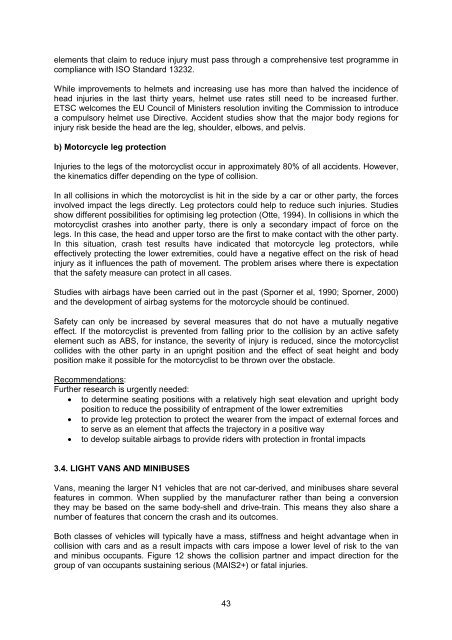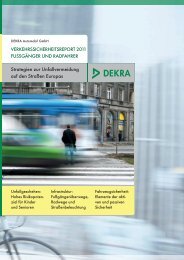PRIORITIES FOR EU MOTOR VEHICLE SAFETY DESIGN
priorities for eu motor vehicle safety design - ETSC
priorities for eu motor vehicle safety design - ETSC
You also want an ePaper? Increase the reach of your titles
YUMPU automatically turns print PDFs into web optimized ePapers that Google loves.
elements that claim to reduce injury must pass through a comprehensive test programme in<br />
compliance with ISO Standard 13232.<br />
While improvements to helmets and increasing use has more than halved the incidence of<br />
head injuries in the last thirty years, helmet use rates still need to be increased further.<br />
ETSC welcomes the <strong>EU</strong> Council of Ministers resolution inviting the Commission to introduce<br />
a compulsory helmet use Directive. Accident studies show that the major body regions for<br />
injury risk beside the head are the leg, shoulder, elbows, and pelvis.<br />
b) Motorcycle leg protection<br />
Injuries to the legs of the motorcyclist occur in approximately 80% of all accidents. However,<br />
the kinematics differ depending on the type of collision.<br />
In all collisions in which the motorcyclist is hit in the side by a car or other party, the forces<br />
involved impact the legs directly. Leg protectors could help to reduce such injuries. Studies<br />
show different possibilities for optimising leg protection (Otte, 1994). In collisions in which the<br />
motorcyclist crashes into another party, there is only a secondary impact of force on the<br />
legs. In this case, the head and upper torso are the first to make contact with the other party.<br />
In this situation, crash test results have indicated that motorcycle leg protectors, while<br />
effectively protecting the lower extremities, could have a negative effect on the risk of head<br />
injury as it influences the path of movement. The problem arises where there is expectation<br />
that the safety measure can protect in all cases.<br />
Studies with airbags have been carried out in the past (Sporner et al, 1990; Sporner, 2000)<br />
and the development of airbag systems for the motorcycle should be continued.<br />
Safety can only be increased by several measures that do not have a mutually negative<br />
effect. If the motorcyclist is prevented from falling prior to the collision by an active safety<br />
element such as ABS, for instance, the severity of injury is reduced, since the motorcyclist<br />
collides with the other party in an upright position and the effect of seat height and body<br />
position make it possible for the motorcyclist to be thrown over the obstacle.<br />
Recommendations:<br />
Further research is urgently needed:<br />
• to determine seating positions with a relatively high seat elevation and upright body<br />
position to reduce the possibility of entrapment of the lower extremities<br />
• to provide leg protection to protect the wearer from the impact of external forces and<br />
to serve as an element that affects the trajectory in a positive way<br />
• to develop suitable airbags to provide riders with protection in frontal impacts<br />
3.4. LIGHT VANS AND MINIBUSES<br />
Vans, meaning the larger N1 vehicles that are not car-derived, and minibuses share several<br />
features in common. When supplied by the manufacturer rather than being a conversion<br />
they may be based on the same body-shell and drive-train. This means they also share a<br />
number of features that concern the crash and its outcomes.<br />
Both classes of vehicles will typically have a mass, stiffness and height advantage when in<br />
collision with cars and as a result impacts with cars impose a lower level of risk to the van<br />
and minibus occupants. Figure 12 shows the collision partner and impact direction for the<br />
group of van occupants sustaining serious (MAIS2+) or fatal injuries.<br />
43



